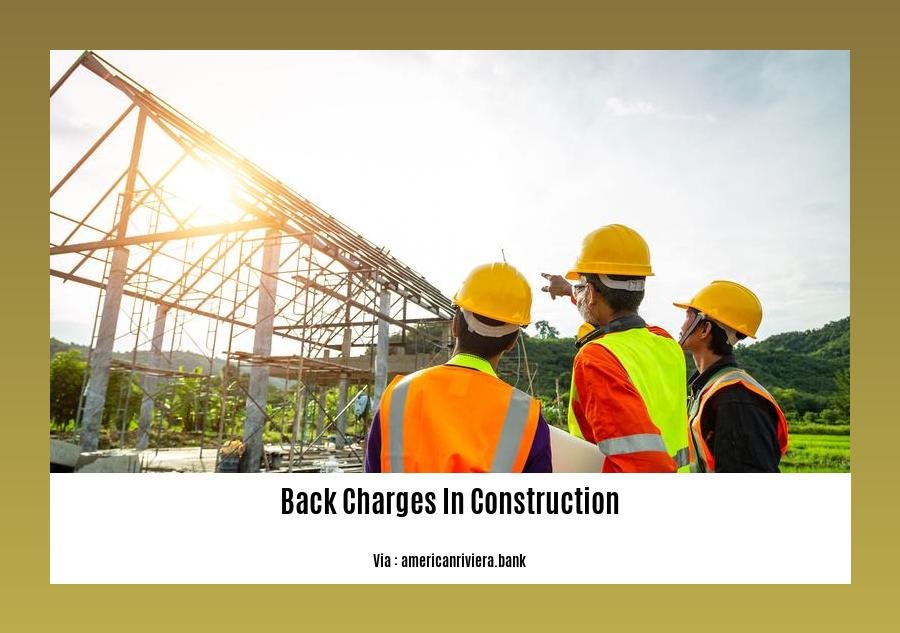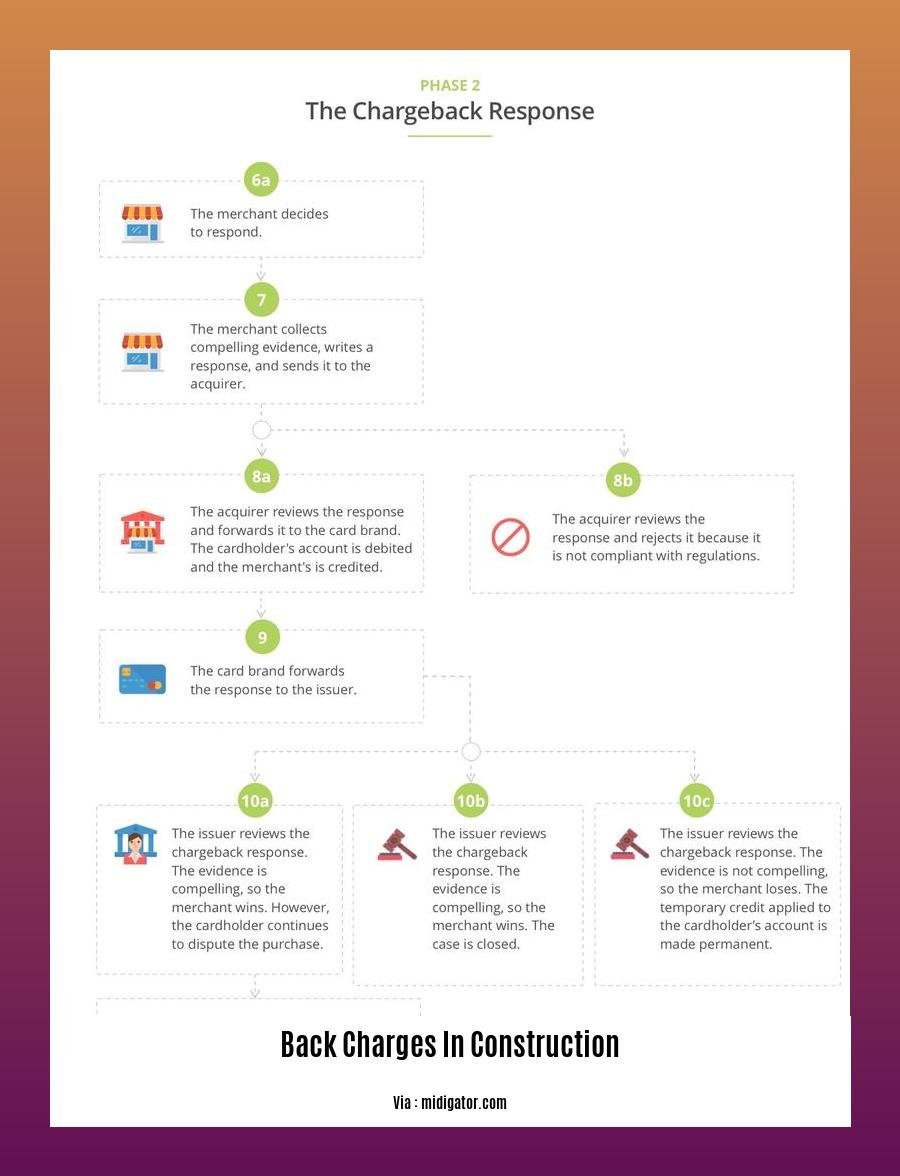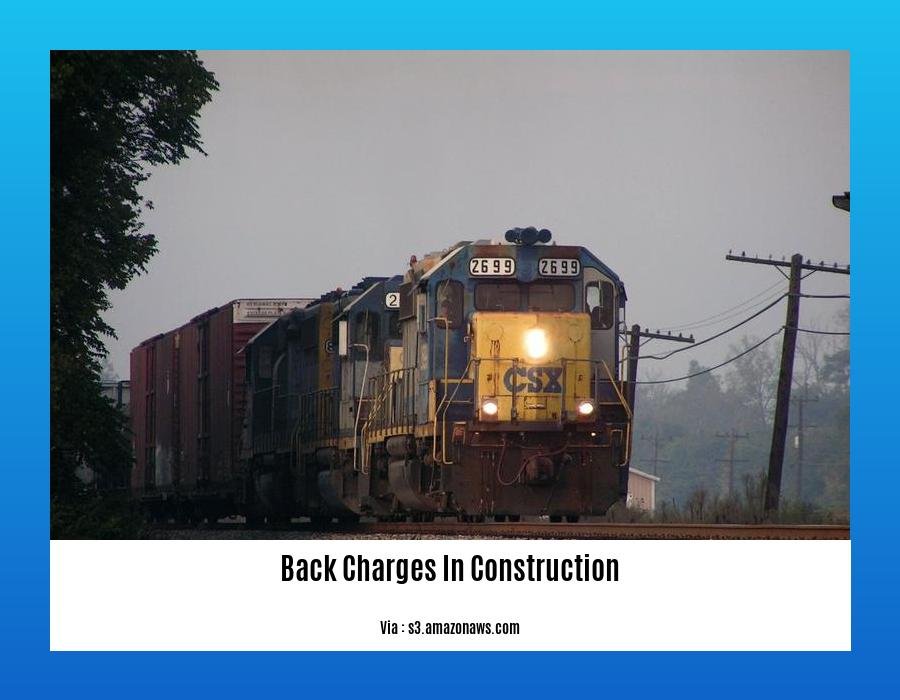**Back Charges in Construction: Legal, Contractual, and Financial Implications** – Back charges, a common occurrence in the construction industry, can have a significant impact on project costs and relationships. Understanding their legal, contractual, and financial implications is crucial for effective project management.
Key Takeaways:
- Back charges are deductions from a subcontractor’s payment for costs incurred by the contractor due to the subcontractor’s work.
- They occur when the contractor has to fix problems in the subcontractor’s work.
- Back charges can be a major source of disputes and delays in construction projects.
- They can be claimed as a set-off or counterclaim against the subcontractor.
- Both contractors and subcontractors have the right to claim payment for work done, even if there is a dispute over back charges.
Back Charges in Construction

Imagine you’re a contractor overseeing a multi-million dollar project. Suddenly, you face unexpected costs due to a subcontractor’s faulty work. What do you do? Enter “back charges” – a deduction from the subcontractor’s payment to cover those extra expenses.
Causes of Back Charges
Back charges arise when the contractor must fix, complete, or make right any deficiencies in the subcontractor’s work. Common triggers include:
- Poor workmanship
- Incomplete tasks
- Delays and disruptions
- Safety violations
How Back Charges Work
Back charges are typically handled through the following steps:
- Identification: The contractor identifies the deficient work and calculates the costs incurred to rectify it.
- Notice: The contractor notifies the subcontractor of the back charges, providing details of the problem and the amount claimed.
- Disputation: The subcontractor may dispute the back charges if they believe they are unjustified or incorrect.
- Negotiation: Contractor and subcontractor negotiate to reach a fair and equitable agreement.
- Adjustment: If an agreement is reached, the subcontractor’s payment is adjusted accordingly.
Pros and Cons of Back Charges
Pros:
- Protects contractors from financial losses due to subcontractor errors
- Ensures project quality and completion
Cons:
- Can disrupt project schedules
- Can lead to disputes and potential litigation
Legal, Contractual, and Financial Implications
Back charges have significant legal, contractual, and financial implications.
- Legal: Back charges must be supported by clear and valid contract terms. The contract should specify the circumstances under which back charges can be assessed and how they are calculated.
- Contractual: The back charge process is governed by the terms of the contract between the contractor and subcontractor. Both parties should carefully review and understand these terms to avoid misunderstandings.
- Financial: Back charges can have a significant financial impact on both contractors and subcontractors. Contractors must ensure that back charges are justified and documented, while subcontractors should ensure that any disputes are handled promptly and fairly.
Conclusion
Back charges in construction are a complex issue that requires careful consideration and management. By understanding the legal, contractual, and financial implications, contractors and subcontractors can navigate the process effectively and protect their interests.
Embark on a quest to find the finest construction contractors in Austin; discover the austin commercial construction companies.
Delve into the dynamic realm of construction loans and unveil the average construction loan interest rate in your region.
Planning a basement renovation? Utilize our basement construction cost calculator Canada to precisely estimate your expenses.
Unveiling the secrets of subterranean construction, explore our comprehensive guide to basement construction method.
Assessing Costs and Liability in Back Charges for Construction

When unexpected costs arise due to subcontractor or vendor errors, back charges become essential tools for contractors to recoup their losses. They serve as a means to restore the project to its intended state and ensure that all parties fulfill their contractual obligations.
Key Takeaways:
- Back charges empower contractors to recover costs incurred due to substandard work, late deliveries, or damages.
- Proper assessment is crucial to determine the cost associated with the back charge.
- Contractors must document and justify back charges clearly to avoid disputes.
- Both parties should carefully review the contract terms to understand the conditions for back charges.
- Liability for back charges is determined by the agreed-upon contract and the specific circumstances of each case.
Steps for Assessing Costs and Liability
-
Identify the Deficient Work or Breach of Contract: Determine the specific instances where the subcontractor or vendor failed to meet their contractual obligations.
-
Calculate the Associated Costs: Estimate the expenses incurred due to the deficient work. This may include labor, materials, equipment, or delays caused by the breach.
-
Notify the Subcontractor or Vendor: Inform the responsible party about the back charge, providing clear documentation of the deficient work and the costs incurred.
-
Review the Contract and Legal Implications: Examine the contract to assess the specific terms and conditions regarding back charges. Consider seeking legal advice if necessary.
-
Negotiate and Dispute Resolution: Engage in discussions with the subcontractor or vendor to resolve the issue amicably. If an agreement cannot be reached, consider formal dispute resolution mechanisms.
Pros and Cons of Back Charges
Pros:
- Protects contractors from financial losses caused by subcontractor errors.
- Ensures project quality and timely completion.
- Provides a mechanism for dispute resolution.
Cons:
- Can disrupt project timelines and schedules.
- May lead to disputes and strained relationships between contractors and subcontractors.
Relevant Sources
Construction Back Charges: Pitfalls to Avoid and the Steps to Take
Recommendations for proper back charges on commercial construction projects
Negotiating and Managing Back Charges
When unexpected costs pop up on a construction project, back charges—also known as chargebacks—step into the ring. They’re like a way for contractors to say, “Hey, you didn’t do what you were supposed to, and now I’m paying for it. Time for a little payback.”
Causes of Back Charges:
– “Subpar Workmanship” – Picture a leaky roof or wonky walls. Back charges can come knocking when the work just doesn’t meet the standards.
– “Incomplete Tasks” – When subcontractors leave projects hanging, contractors are left holding the bag. Back charges can help fill the gaps.
– “Delays and Disruptions” – Think traffic jams on the construction site. Back charges can reimburse contractors for those unplanned delays.
– “Safety Violations” – Oops, someone forgot their hard hat. Back charges can serve as a reminder to prioritize safety.
How Back Charges Work:
1. Identify the Problem, calculate the cost, and document everything.
2. Notify the Subcontractor: Let them know what’s up and why they’re getting a back charge.
3. Resolve Disputes: If there’s a disagreement, contractors can take the issue to arbitration or court.
4. Negotiation and Payment: Time to talk it out and come to a fair solution. Payment adjustments might be on the table.
Pros:
– Cost Recovery: Contractors can get reimbursed for extra expenses caused by subcontractor errors.
– Project Quality: Back charges encourage subcontractors to up their game and deliver quality work.
Cons:
– Schedule Delays: Back charges can disrupt project schedules if disputes arise.
– Disputes and Litigation: If negotiations hit a dead end, legal battles can ensue.
Negotiating and Managing Back Charges:
– Stay Calm and Communicate: Keep your cool and communicate clearly. Back charges can be stressful, but it’s best to approach them professionally.
– Document, Document, Document: Keep a detailed record of all costs and communication related to the back charge. It’s like building a fortress of evidence.
– Negotiate Fairly: Be reasonable in your cost calculations and payment expectations. Remember, it’s about finding a solution that works for both parties.
– Consider Mediation: If you can’t reach an agreement on your own, consider bringing in a mediator to help facilitate negotiations.
– Seek Legal Advice: If all else fails, don’t shy away from legal counsel. An attorney can guide you through the complexities of back charge disputes.
Key Takeaways:
- Back charges allow contractors to recoup costs incurred due to subcontractor mistakes or delays.
- Causes of back charges range from poor workmanship to safety violations.
- Back charges can have both benefits (cost recovery) and drawbacks (project delays).
- Proper negotiation and documentation are crucial for managing back charges effectively.
- In case of disputes, consider mediation or legal assistance.
Relevant URL Sources:
- Construction Back Charges: Pitfalls to Avoid and the Steps to Success – ProCrew Schedule
- Back Charges in Construction Practice – International Bar Association
Best Practices for Back Charge Administration
Back charges in construction, when managed well, help ensure project quality and protect contractors from subcontractor errors. Here are some key takeaways to help you navigate back charges effectively:
Key Takeaways:
- Establish a clear contractual framework outlining when and how back charges can be levied.
- Communicate openly and regularly to identify and address potential issues early on.
- Document all changes to the project scope, schedule, and materials.
- Keep meticulous records of expenses incurred due to back charges.
- Foster a collaborative relationship with contractors and subcontractors to minimize disputes.
- Consider involving legal counsel if a back charge dispute arises.
Additional Best Practices:
- Negotiate Back Charges Fairly: Both parties should approach back charge negotiations with a fair and reasonable mindset, considering the specific circumstances and contractual obligations.
- Document Back Charges Thoroughly: Provide detailed documentation to support back charge claims, including evidence of the deficient work, cost calculations, and communication attempts with the responsible party.
- Establish Dispute Resolution Mechanisms: Outline a clear process for resolving back charge disputes, such as mediation or arbitration, to avoid protracted legal battles.
- Regularly Review Back Charge Administration: Regularly assess your back charge administration practices to identify areas for improvement and ensure compliance with industry best practices.
By following these best practices, you can effectively manage back charges in construction projects, protect your interests, and maintain a positive working relationship with your contractors.
Relevant URL Sources:
- Back Charge in Construction: Causes, Calculations, and Management
- How to Avoid Back Charges in Construction Projects
FAQ
Q1: What are the most common causes of back charges in construction?
Q2: What are the legal implications of back charges, and how can contractors protect themselves?
Q3: How can contractors assess and calculate back charges fairly?
Q4: What are some strategies for negotiating and resolving back charge disputes?
Q5: What are the potential financial consequences of back charges for contractors and subcontractors?
- The Best Battery Picture Lamps for Effortless Artwork Illumination - April 1, 2025
- Double Sink Bath Vanity Tops: A Buyer’s Guide - April 1, 2025
- Bath Towel Measurements: A Complete Guide to Choosing the Right Size - April 1, 2025










